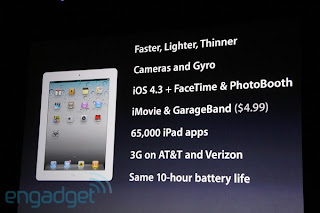The iPad is a line of tablet computers designed, developed and marketed by Apple Inc., primarily as a platform for audio-visual media including books, periodicals, movies, music, games, and web content. The iPad was introduced on January 27, 2010 by Apple's then-CEO Steve Jobs. Its size and weight fall between those of contemporary smartphones and laptop computers. The iPad runs the same operating system as the iPod Touch and iPhone—and can run its own applications as well as iPhone applications. Without modification, the iPad will only run programs approved by Apple and distributed via the Apple App Store (with the exception of programs that run inside the iPad's web browser).
 |
| iPad 2 |
Like iPhone and iPod Touch,
the iPad is controlled by a multitouch display—a departure from most previous tablet computers, which used a pressure-triggered stylus—as well as a virtual onscreen keyboard in lieu of a physical keyboard. The iPad uses a Wi-Fi connection to access local area networks and the Internet. Some models also have a 3G wireless network interface which can connect to HSPA or EV-DO data networks and on to the Internet. Since the release of iOS 5, the device does not need to be managed and synced by iTunes running on a personal computer via USB cable.
Apple released the first iPad in April 2010, and sold 3 million of the devices in 80 days. During 2010, Apple sold 14.8 million iPads worldwide, representing 75 percent of tablet PC sales at the end of 2010.
By the release of the iPad 2 in March 2011, more than 15 million iPads had been sold—selling more than all other tablet PCs combined since the iPad's release. In 2011, it is expected to take 83 percent of the tablet computing market share in the United States.
iPad 2 |
| iPad 2 |
Apple Inc. CEO Steve Jobs unveiled the
iPad 2, the second generation of the device, at a March 2, 2011, press conference, despite being on medical leave at the time. About 33% thinner than its predecessor, the iPad 2 has a better processor, a dual core Apple A5 that Apple says is twice as fast as its predecessor for CPU operations and up to nine times as fast for GPU operations. It includes front and back cameras that support the FaceTime video calling application, as well as a three-axis gyroscope. It retains the original's 10-hour battery life and has a similar pricing scheme.
The iPad 2 has been available for purchase, depending on stock availability, since March 11, 2011, at Apple retail stores in the United States, as well as to United States customers shopping online at Apple's retail website. The iPad 2 was released internationally in 25 other countries on March 25, 2011, including Australia, Canada, France, Germany, Mexico and the United Kingdom, but not Japan as originally scheduled due to the earthquake and tsunami.
The iPad 2 uses the iOS 5 software that was released on October 12, 2011 and is supposed to bring over 200 new user features including Notification Center, iMessage, and an updated notifications system, using a new "banner" style instead of the originally used pop-up "alert" style. The iPad 2 comes with Photo Booth, an application in which users can take photos and effects on them. The iPad 2 also adds to capability to support GarageBand, iMovie, and the iWork apps Pages, Keynote, and Numbers. These applications do not come with the iPad but are instead official applications from Apple sold within the App Store.

